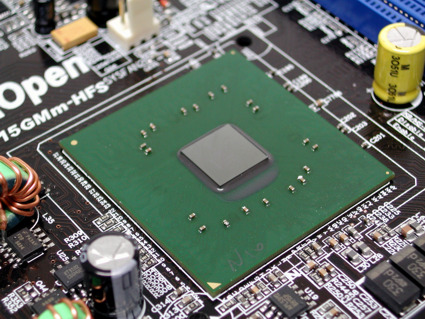The Next Generation of Cool: AOpen's 37 Watt Pentium M Desktop PC
915GM: Low-Power Player
The 915M mobile chipset. Its advantage: it draws less power than its desktop sibling.
Both Intel's 915 and 955 PCI Express enabled chipsets heat up noticeably during operation, necessitating large heatsinks. The 915-GM northbridge and the ICH6-M, on the other hand, are only warm to the touch and don't require any kind of cooling.
To reduce the chipset's power consumption, Intel had to lower the signal strength between the northbridge and the ICH6-M considerably. As a result, the maximum supported FSB is 533 MHz; higher frequencies automatically mean much higher dissipation loss. Consequently, the amplifier components are also weaker, which can be a limiting factor when attempting to overclock the system.
Obviously, mobile technology has its limitations. For example, the clock speeds that are to be used in a certain generation of mobile systems have to be selected appropriately according to the technical potential of the whole system and its intended use. It makes a huge difference in the design whether a 915GM system is running at FSB400 or FSB533, which is why users usually can't choose between these two CPU types - their notebook's motherboard is only engineered for one or the other.
That said, AOpen has designed the 915GMm-HFS in such a way that both FSB speeds can be used. The correct FSB is selected using jumpers on the board.
Get Tom's Hardware's best news and in-depth reviews, straight to your inbox.
Current page: 915GM: Low-Power Player
Prev Page Pentium M: The Unrecognized Genius Next Page AOpen I915Gmm-HFS
Patrick Schmid was the editor-in-chief for Tom's Hardware from 2005 to 2006. He wrote numerous articles on a wide range of hardware topics, including storage, CPUs, and system builds.

